Abstract
In 1970, Herrnstein proposed a simple equation to describe the relation between response and reinforcement rates on interval schedules. Its empirical basis is firm, but its theoretical foundation is still uncertain. Two approaches to the derivation of Herrnstein's equation are discussed. It can be derived as the equilibrium solution to a process model equivalent to familiar linear-operator learning models. Modifications of this approach yield competing power-function formulations. The equation can also be derived from the assumption that response strength is proportional to reinforcement rate, given that there is a ceiling on response rate. The proportional relation can, in turn, be derived from a threshold assumption equivalent to Shimp's “momentary maximizing”. This derivation implies that the two parameters of Herrnstein's equation should be correlated, and may explain its special utility in application to internal schedules.
Keywords: Herrnstein's equation, learning models, process models, parameters, momentary maximizing, equilibrium models, optimal behavior, interval schedules
Full text
PDF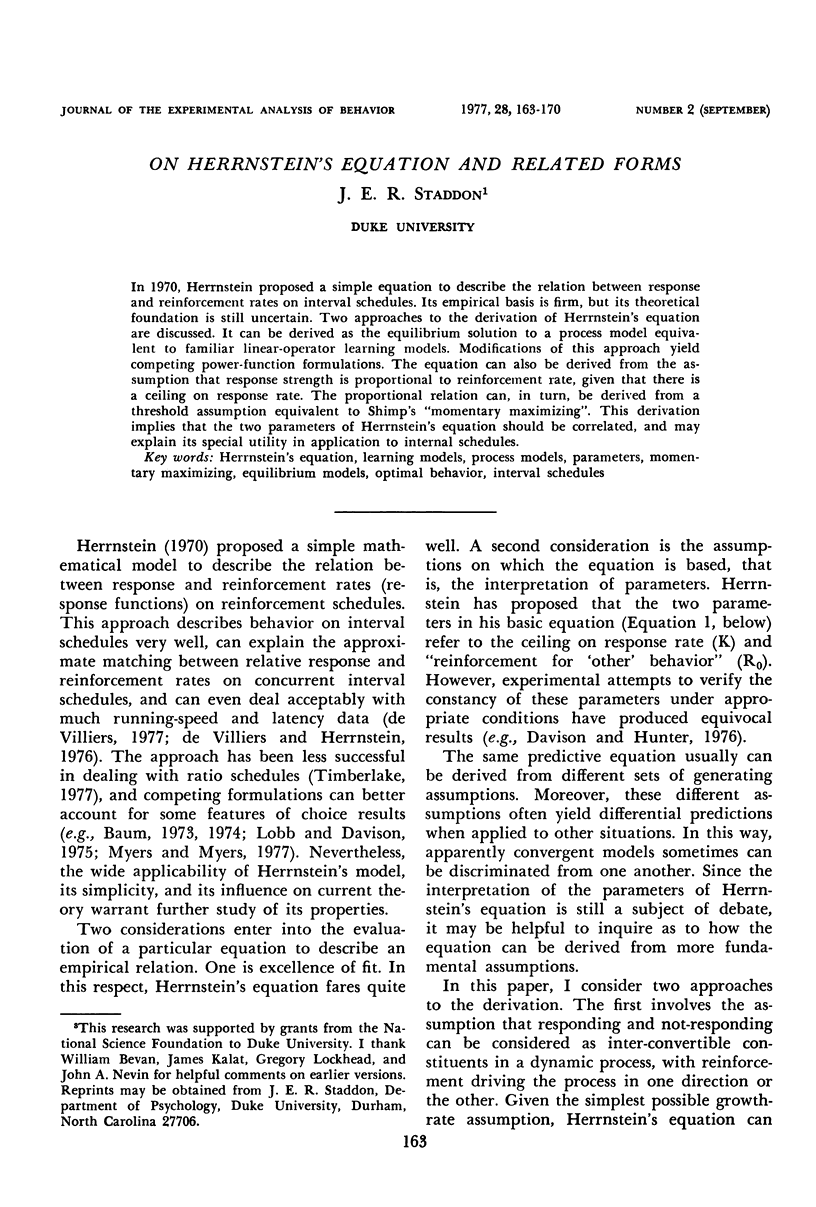

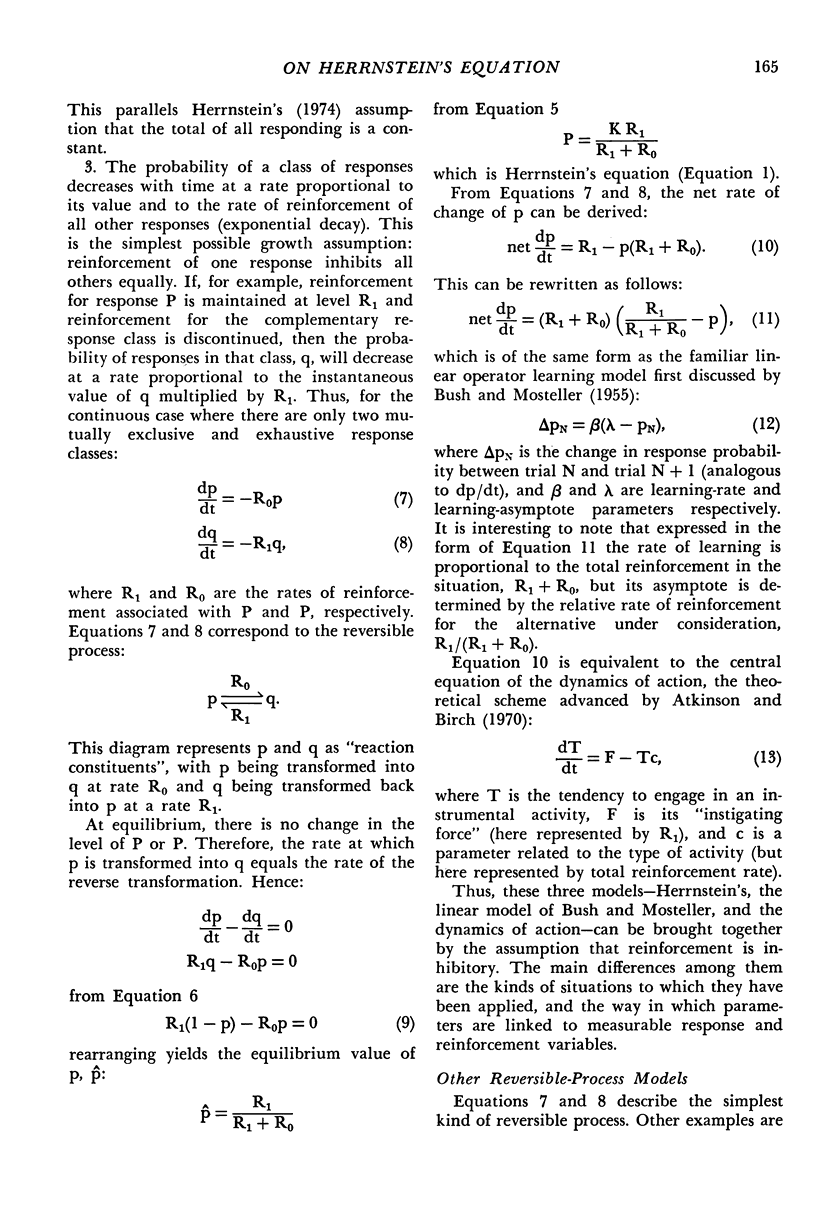
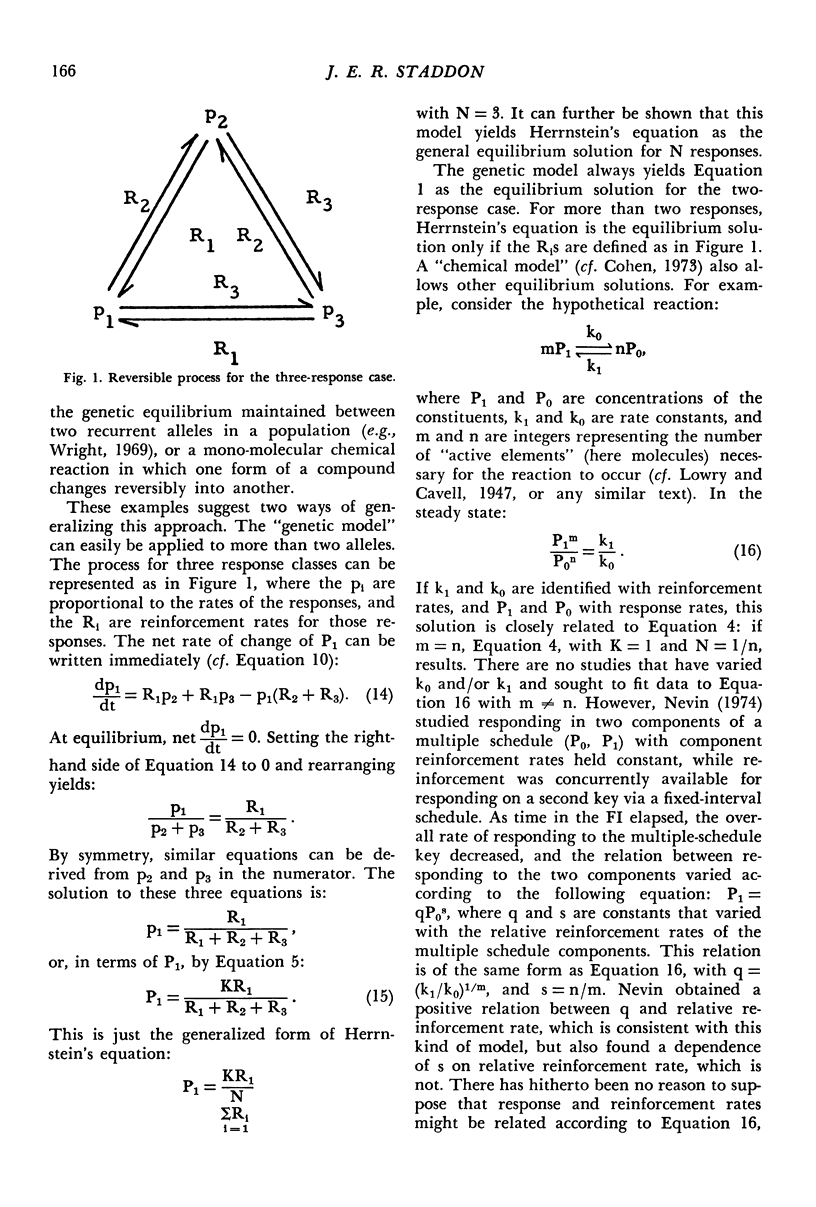
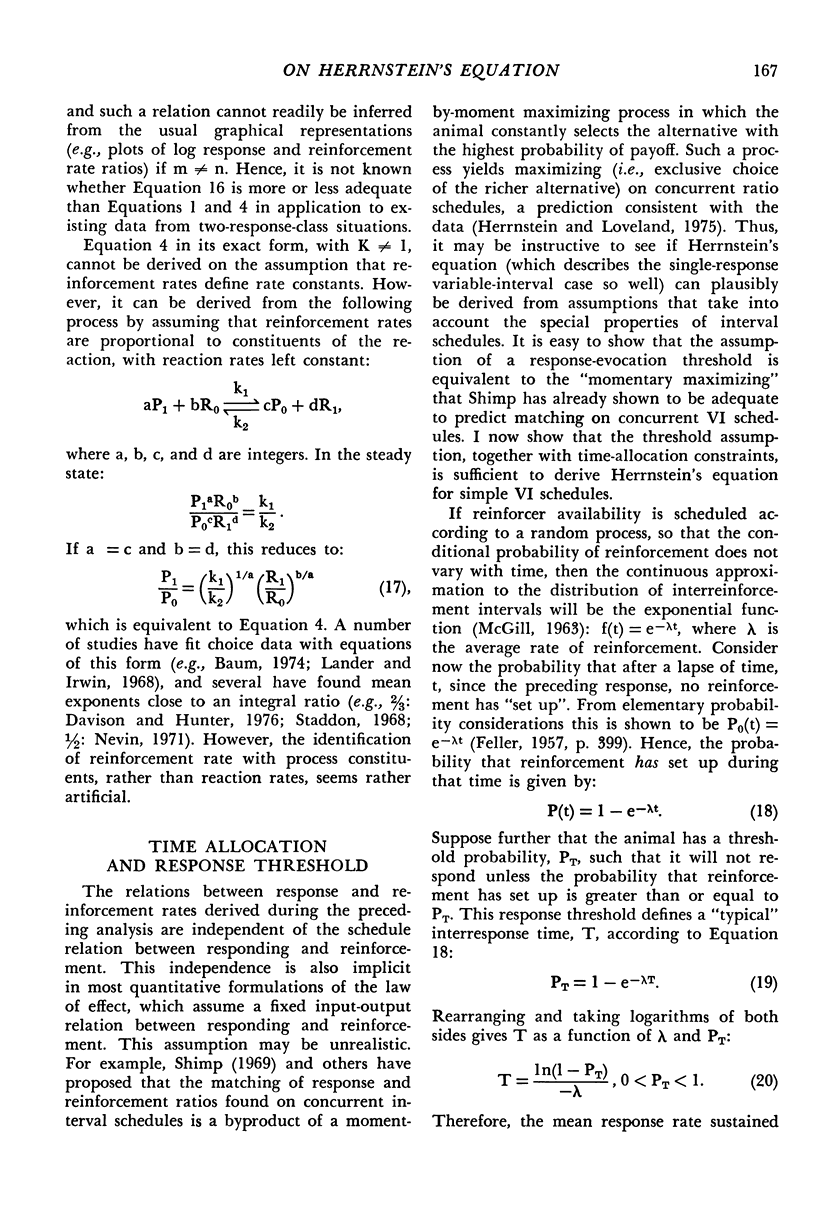
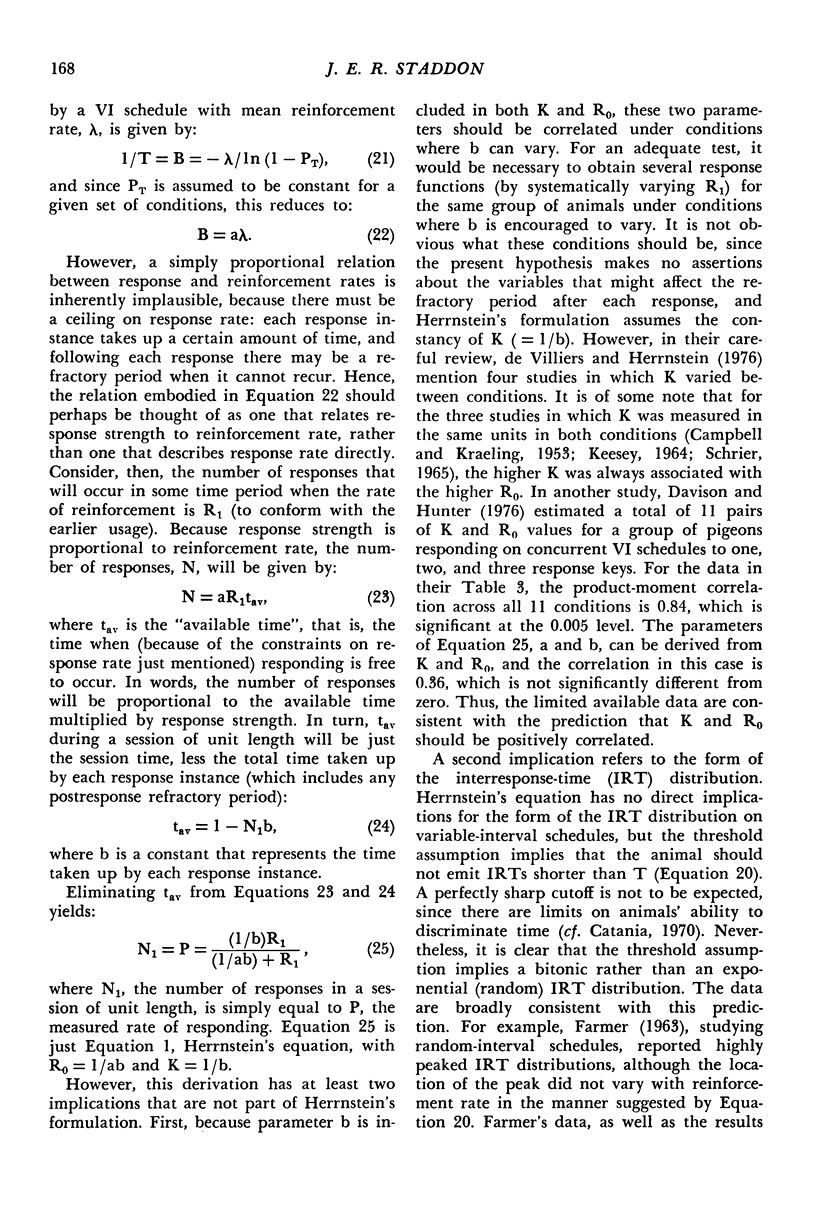
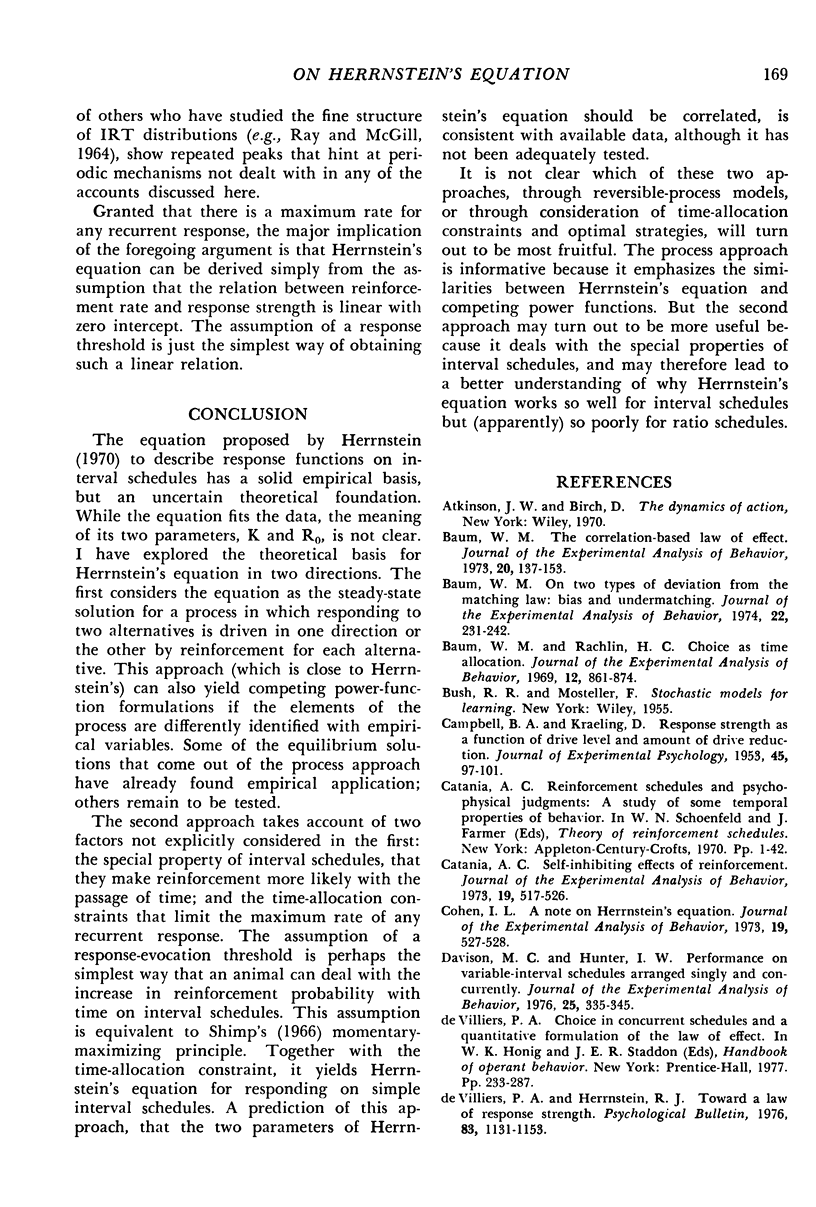
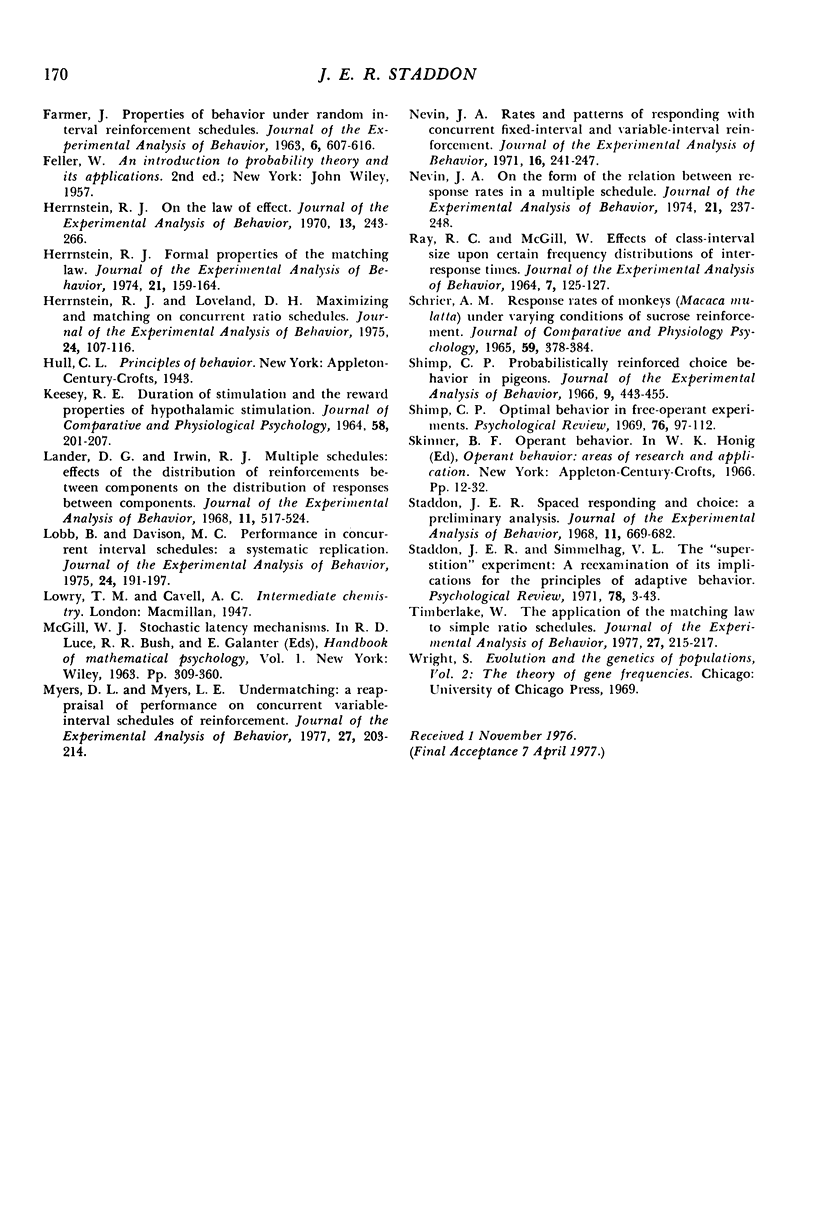
Selected References
These references are in PubMed. This may not be the complete list of references from this article.
- Baum W. M. On two types of deviation from the matching law: bias and undermatching. J Exp Anal Behav. 1974 Jul;22(1):231–242. doi: 10.1901/jeab.1974.22-231. [DOI] [PMC free article] [PubMed] [Google Scholar]
- Baum W. M., Rachlin H. C. Choice as time allocation. J Exp Anal Behav. 1969 Nov;12(6):861–874. doi: 10.1901/jeab.1969.12-861. [DOI] [PMC free article] [PubMed] [Google Scholar]
- Baum W. M. The correlation-based law of effect. J Exp Anal Behav. 1973 Jul;20(1):137–153. doi: 10.1901/jeab.1973.20-137. [DOI] [PMC free article] [PubMed] [Google Scholar]
- CAMPBELL B. A., KRAELING D. Response strength as a function of drive level and amount of drive reduction. J Exp Psychol. 1953 Feb;45(2):97–101. doi: 10.1037/h0060223. [DOI] [PubMed] [Google Scholar]
- Catania A. C. Self-inhibiting effects of reinforcement. J Exp Anal Behav. 1973 May;19(3):517–526. doi: 10.1901/jeab.1973.19-517. [DOI] [PMC free article] [PubMed] [Google Scholar]
- Cohen I. L. A note on Herrnstein's Equation. J Exp Anal Behav. 1973 May;19(3):527–528. doi: 10.1901/jeab.1973.19-527. [DOI] [PMC free article] [PubMed] [Google Scholar]
- Davison M. C., Hunter I. W. Performance on variable-interval schedules arranged singly and concurrently. J Exp Anal Behav. 1976 May;25(3):335–345. doi: 10.1901/jeab.1976.25-335. [DOI] [PMC free article] [PubMed] [Google Scholar]
- FARMER J. PROPERTIES OF BEHAVIOR UNDER RANDOM INTERVAL REINFORCEMENT SCHEDULES. J Exp Anal Behav. 1963 Oct;6:607–616. doi: 10.1901/jeab.1963.6-607. [DOI] [PMC free article] [PubMed] [Google Scholar]
- Herrnstein R. J. Formal properties of the matching law. J Exp Anal Behav. 1974 Jan;21(1):159–164. doi: 10.1901/jeab.1974.21-159. [DOI] [PMC free article] [PubMed] [Google Scholar]
- Herrnstein R. J., Loveland D. H. Maximizing and matching on concurrent ratio schedules. J Exp Anal Behav. 1975 Jul;24(1):107–116. doi: 10.1901/jeab.1975.24-107. [DOI] [PMC free article] [PubMed] [Google Scholar]
- Herrnstein R. J. On the law of effect. J Exp Anal Behav. 1970 Mar;13(2):243–266. doi: 10.1901/jeab.1970.13-243. [DOI] [PMC free article] [PubMed] [Google Scholar]
- KEESEY R. E. DURATION OF STIMULATION AND THE REWARD PROPERTIES OF HYPOTHALAMIC STIMULATION. J Comp Physiol Psychol. 1964 Oct;58:201–207. doi: 10.1037/h0043134. [DOI] [PubMed] [Google Scholar]
- Lander D. G., Irwin R. J. Multiple schedules: effects of the distribution of reinforcements between component on the distribution of responses between conponents. J Exp Anal Behav. 1968 Sep;11(5):517–524. doi: 10.1901/jeab.1968.11-517. [DOI] [PMC free article] [PubMed] [Google Scholar]
- Lobb B., Davison M. C. Performance in concurrent interval schedules: a systematic replication. J Exp Anal Behav. 1975 Sep;24(2):191–197. doi: 10.1901/jeab.1975.24-191. [DOI] [PMC free article] [PubMed] [Google Scholar]
- Myers D. L., Myers L. E. Undermatching: a reappraisal of performance on concurrent variable-interval schedules of reinforcement. J Exp Anal Behav. 1977 Jan;27(1):203–214. doi: 10.1901/jeab.1977.27-203. [DOI] [PMC free article] [PubMed] [Google Scholar]
- Nevin J. A. On the form of the relation between response rates in a multiple schedule. J Exp Anal Behav. 1974 Mar;21(2):237–248. doi: 10.1901/jeab.1974.21-237. [DOI] [PMC free article] [PubMed] [Google Scholar]
- Nevin J. A. Rates and patterns of responding with concurrent fixed-interval and variable-interval reinforcement. J Exp Anal Behav. 1971 Sep;16(2):241–247. doi: 10.1901/jeab.1971.16-241. [DOI] [PMC free article] [PubMed] [Google Scholar]
- RAY R. C., MCGILL W. EFFECTS OF CLASS-INTERVAL SIZE UPON CERTAIN FREQUENCY DISTRIBUTIONS OF INTER-RESPONSE TIMES. J Exp Anal Behav. 1964 Jan;7:125–127. doi: 10.1901/jeab.1964.7-125. [DOI] [PMC free article] [PubMed] [Google Scholar]
- SCHRIER A. M. RESPONSE RATES OF MONKEYS (MACACA MULATTA) UNDER VARYING CONDITIONS OF SUCROSE REINFORCEMENT. J Comp Physiol Psychol. 1965 Jun;59:378–384. doi: 10.1037/h0022064. [DOI] [PubMed] [Google Scholar]
- Shimp C. P. Probabilistically reinforced choice behavior in pigeons. J Exp Anal Behav. 1966 Jul;9(4):443–455. doi: 10.1901/jeab.1966.9-443. [DOI] [PMC free article] [PubMed] [Google Scholar]
- Staddon J. E. Spaced responding and choice: a preliminary analysis. J Exp Anal Behav. 1968 Nov;11(6):669–682. doi: 10.1901/jeab.1968.11-669. [DOI] [PMC free article] [PubMed] [Google Scholar]


